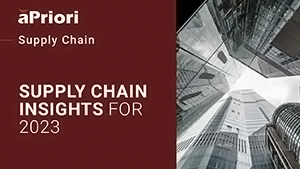Video
How to Build a Resilient Supply Chain for 2023
What are the supply chain trends to know for 2023? Join aPriori and John Pilla, formerly of Spirit Aerosystems, to learn more about what executives should be doing to build a resilient supply chain for 2023.
What should executives be most concerned about this year? The biggest supply chain disrupters include labor inflation, sustainability targets, and more.
Watch this short and insightful customer interview to learn more.

Transcript
LA: I’m here with John Pilla, who is one of the members of our Executive Advisory Board, an expert in the aerospace industry, formerly with Spirit AeroSystems. So you were all day yesterday in session with our executive VIPs. Can you give me, without giving too much away, what is the over and under on what our executives are seeing in 2022 and expecting in 2023?
JP: It was very interesting to me that supply chain executives were the ones talking yesterday, not really engineers. And so the supply chain’s buying-in in these companies that are getting the biggest bang for their buck.
LA: Do you think supply chain folks have really gotten a bigger spotlight on them in the past year than maybe design engineers, maybe because of the shortages that we’ve seen or the real crises worldwide, such as the global pandemic?
JP: Absolutely. The Chief Executive Officer talked about the four things that everybody’s worried about and working on it. And one of the four is the global supply chain.
LA: What are the other four? Because now you’re like, I’m on the edge of my seat. I got to know.
JP: What are the other three?
JP: Labor is one. And I’ll feel bad if I can’t exactly get all four. The ones that kicked me were labor, because everyone was nodding. And then the supply chain snarls. Then there’s other global things like inflation that no one can really control, so.
LA: And I bet the last one is the sustainability targets that are coming around. Everyone cares about sustainability. Not everyone is prepared to meet the real targets that are being set by regulation, that are being set internally by companies.
JP: Agreed. We saw some interesting statistics. About 97% of companies, for example, want to have a green plan, want to reduce emissions. And then it turns into a small percentage that actually are able to execute and make a difference, at least short term. So that will continue to be a part of all of consumer industry.
LA: Can you give us just a little snippet, a sneak peek of the case study, what you’re going to talk about there?
Should Cost Technology for Procurement Optimization with Parts Suppliers
JP: Spirit has been using aPriori in initiatives close to 10 years, about the same as the length of the company. And we had a great effort to do detail analysis of parts to try and decide what the should cost is on those fabrication parts. And we did it with our fabrication division. They didn’t have very many tools. They didn’t have much data to be able to do that themselves. And now we can show them this part’s $5, this part’s $10.
LA: And how has that transformed Spirit’s profitability over those 10 years?
JP: Well, it allows you to have the fabrication folks work with the engineers and just be able to reduce the cost of those parts. Spirit is a company like most that buys a lot of their parts. And the ability to reduce the costs on them will change the game in terms of profitability and cash flow, which keeps that business going.
LA: Do you think other companies need to be at the scale of Spirit in the airline industry in order to take advantage of these cost savings?
JP: No, I would actually say a smaller company probably could do “better faster”. Smaller teams, better communication. And in cars, for example, pennies count. Pennies count. And so it would be absolutely necessary for those kind of companies to use these kind of tools.
LA: I’m going to think about next time I see a penny on the ground, you know, they used to have that saying, like, find a penny, pick it up. All the day you’ll have…
JP: All the day you’ll have a good luck, yeah.
LA: I’m going to think about this. Case study, next time I see a penny, I’m going to say, okay, even a small company can take advantage of digital transformation of manufacturing. That’s going to be my takeaway from this conversation.
JP: That’s good. All right.
LA: John, thank you so much for talking to me today.
JP: Hey, thank you.

